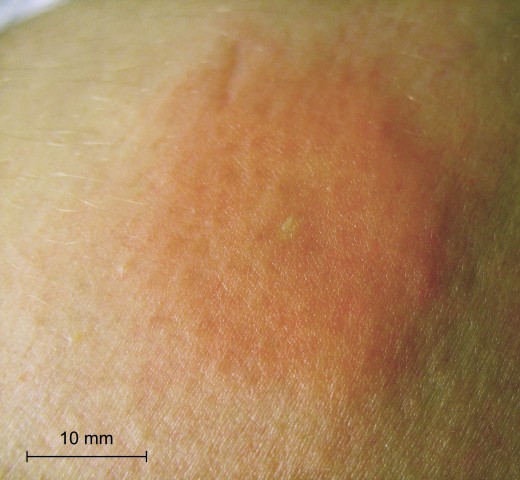
However, on occasion, the stinger is present at the initial examination. 2 Frequently, the honeybee stinger is removed from the site of sting prior to medical presentation. The range of complications are dependent on the ocular site of the sting and may include toxic keratopathy with severe, persistent corneal edema, 1 keratouveitis, raised intraocular pressure, cataract formation, lens subluxation, hyphema, iris atrophy, optic neuritis, and toxic endophthalmitis. Bee stings to the eye may be extremely serious and threaten visual function. The high index of suspicion based on the clinical examination, results of imaging and aggressive antibiotic therapy, and early removal of sting may likely prevent fatal outcome.Ocular injuries from bee stings are an uncommon occurrence in urban populations and optimal treatment has not yet been established. The strength of the report was the diagnosis of CST by clinical and imaging, isolation of infective agent, and successful management of the case. The culture of a specimen from the lesion yielded Staphylococcus aureus and Streptococcus pyogenes which were in line with previous reports. In addition, the local edema may impair lymphatic drainage and reduce clearance of the infection by the immune system. Thus, bee sting may facilitate introduction of infection, if the sting remains or not cautiously removed.Īlso, scratching due to itching can cause further epidermal injury and intra dermal implantation of pathogenic bacteria. Direct inoculation of any bacteria into the epidermis can occur from the insect's body or the surface of the victim's skin. It is also known that bees are occasionally attracted by garbage, and their hairy abdomen gets contaminated with pathogenic microbes. Infections following bee sting are rather uncommon and no field studies were carried out to establish the extent to which bees are contaminated by pathogenic microorganisms. Earlier isolated cerebral and cerebellar infarction following bee sting were reported. The thrombogenic substances of the venom might have induced thrombophlebitis of the facial vein which also might have got infected. In our patient, squeezing the lip after 3 hours and delay in the removal of stinger might have resulted in more envenomation. Failing to appreciate these signs may delay the diagnosis and enhance the spread of infection as seen in this case. Headache is the most common presenting symptom and periorbital edema may be the earliest physical sign. CST is a serious neurological complication if infection develops in the medial third of the face, a critical area of face with rich venous plexus. He was treated with intravenous vancomycin, ceftriaxone, and clindamycin and he recovered well. Meanwhile, the results of culture specimen from the lesion yielded Staphylococcus aureus and Streptococcus pyogenes. Contrast-enhanced magnetic resonance imaging (MRI) which demonstrated swollen non-enhancing cavernous sinus and narrowed internal carotid artery this was consistent with the diagnosis of CST. In view of headache and ocular findings, a preliminary diagnosis of CST was made. Ocular examination revealed lid edema, narrow palpebral aperture, chemosis, marked restriction of ocular motility out of proportion to the degree of proptosis, loss of pupillary light reflex, and low-grade optic disc edema with dilated retinal veins on left side. On examination, he was irritable, febrile and hypoxic, which led to invasive ventilation. As he developed confusion, he was transferred to our institution.

He became more lethargic and started moaning, and treated as orbital cellulitis for two days. The patient went to the nearest healthcare center and was treated symptomatically. Over the next 48 hours, he had developed facial swelling, headache, and eye pain on left side along with vomiting. His son squeezed to remove the sting after 3 hours. A 58-year-old male farmer without any comorbid illness was stung by a bee in the left side of the upper lip. We report a case of cavernous sinus thrombosis (CST) following bee sting in view of its rarity and make clinicians to consider this entity in the differential diagnosis of CST.

Bee (hymenoptera) stings can cause a wide range of reactions, but infections following stings are uncommon.


 0 kommentar(er)
0 kommentar(er)
